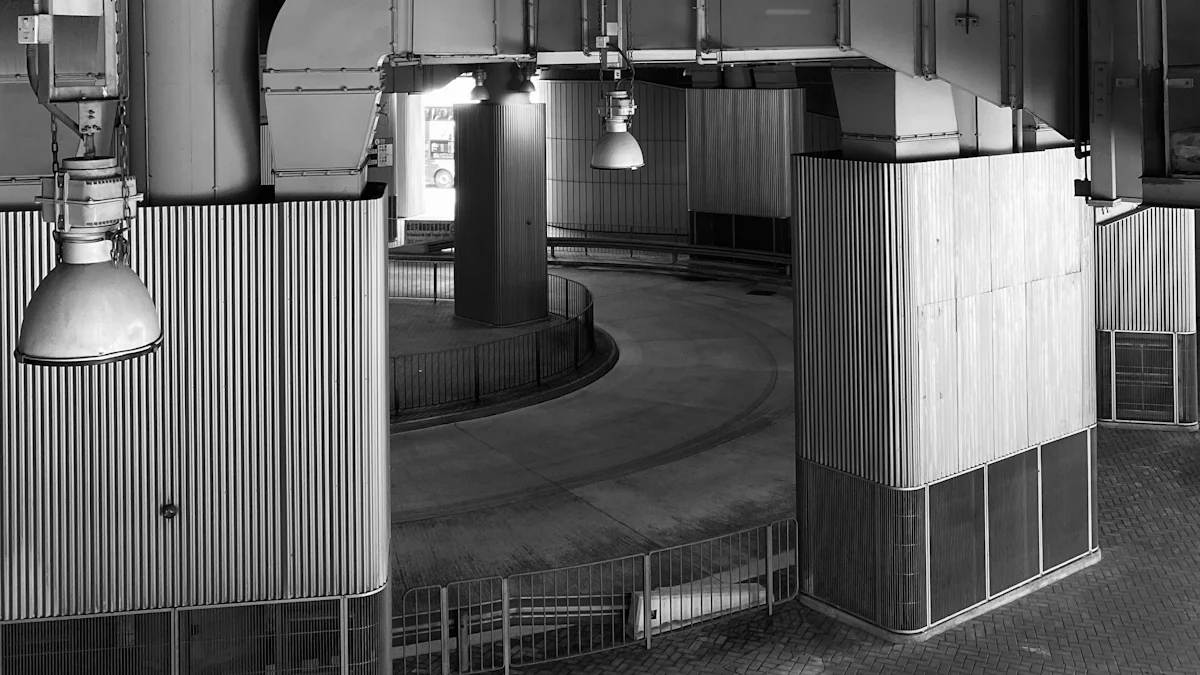Tunnel Freezers: What Temperature Do They Reach?

Tunnel freezers operate at extremely low temperatures, reaching as low as -196 °C. These freezers play a crucial role in preserving the quality of various products. Understanding what temperature is a tunnel freezer is essential for selecting the right equipment for specific applications. For instance, cryogenic tunnel freezers can achieve internal temperatures of -130°F (-90°C), making them suitable for rapid freezing needs. Different foods require varying freezing temperatures, typically ranging from -18°C to -30°C. Selecting the appropriate refrigerant, such as ammonia or R404A, ensures optimal performance.
What temperature is a tunnel freezer?
Tunnel freezers operate at various temperatures depending on their type and application. Understanding these temperatures helps in selecting the right equipment for specific needs.
Mechanical Tunnel Freezers
Mechanical tunnel freezers use refrigeration systems to achieve desired temperatures. They are commonly used in food processing industries.
Typical Temperature Range
Mechanical tunnel freezers typically maintain temperatures between -20°C and -40°C. This range ensures optimal freezing quality for a variety of products. Delicate food items might require slightly higher temperatures compared to sturdier products. These freezers are essential for manufacturers needing quick and efficient freezing.
Factors Affecting Temperature
Several factors influence the temperature in mechanical tunnel freezers:
Refrigerant Type: The choice of refrigerant, such as ammonia or R404A, impacts the efficiency and temperature range.
Product Load: The amount and type of product being frozen can affect the internal temperature.
Ambient Conditions: External temperature and humidity levels can also play a role in maintaining the desired temperature.
Cryogenic Tunnel Freezers
Cryogenic tunnel freezers utilize gases like liquid nitrogen or carbon dioxide to achieve extremely low temperatures. They are ideal for rapid freezing applications.
Typical Temperature Range
Cryogenic tunnel freezers can reach temperatures as low as -196°C. This capability makes them suitable for freezing products like meat patties, poultry, and prepared entrees. The ultra-low temperatures ensure rapid freezing, preserving the quality and texture of the products.
Factors Affecting Temperature
The temperature in cryogenic tunnel freezers depends on:
Gas Type: Liquid nitrogen and carbon dioxide have different freezing capabilities.
Product Type: Different products may require specific temperature settings to prevent thermal shock or dehydration.
System Design: The design and construction of the freezer, often made of stainless steel, ensure efficient operation and long service life.
Understanding what temperature is a tunnel freezer helps industries choose the right equipment for their specific freezing needs. Both mechanical and cryogenic tunnel freezers offer unique advantages depending on the application.
Types of Tunnel Freezers

Tunnel freezers come in two main types: mechanical and cryogenic. Each type operates on distinct principles and serves specific applications in the food industry.
Mechanical Tunnel Freezers
Mechanical tunnel freezers rely on refrigeration systems to achieve desired temperatures. They are widely used in food processing due to their efficiency and reliability.
Operational Principles
Mechanical tunnel freezers use a continuous transport system to move products through a refrigerated tunnel. This system ensures consistent exposure to cold air, which rapidly cools the products. The refrigeration process involves compressors, condensers, and evaporators that work together to maintain low temperatures. The choice between mesh belt and solid belt designs can impact the freezing process and product quality. Mesh belts allow for better airflow, while solid belts provide more support for delicate items.
Typical Applications
Mechanical tunnel freezers are ideal for freezing uniform products with similar requirements. They are commonly used for freezing vegetables, fruits, and bakery items. These freezers enhance the preservation and safety of food by ensuring rapid and uniform freezing. Manufacturers benefit from increased production rates due to faster freezing times compared to traditional methods.
Cryogenic Tunnel Freezers
Cryogenic tunnel freezers utilize gases like liquid nitrogen or carbon dioxide to achieve extremely low temperatures. They offer unique advantages for rapid freezing applications.
Operational Principles
Cryogenic tunnel freezers operate by exposing products to cryogenic gases, which quickly absorb heat and lower the temperature. This method prevents thermal shock, yield loss, and dehydration. The system design, often made of stainless steel, ensures trouble-free operation and a long service life. The precise control of temperature and airflow allows for rapid cooling, making these freezers highly efficient.
Typical Applications
Cryogenic tunnel freezers are versatile and easily adjusted to meet various chilling and freezing requirements. They are suitable for products like meat patties, poultry, prepared entrees, muffins, and pizzas. The ultra-low temperatures achieved by these freezers preserve the quality and texture of the products, making them ideal for high-quality food preservation.
Understanding what temperature is a tunnel freezer helps industries choose the right equipment for their specific freezing needs. Both mechanical and cryogenic tunnel freezers offer unique advantages depending on the application.
Choosing the Right Tunnel Freezer
Selecting the appropriate tunnel freezer involves evaluating several factors to ensure it meets specific operational needs. Both mechanical and cryogenic tunnel freezers offer distinct advantages, and understanding these can guide industries in making informed decisions.
Considerations for Mechanical Freezers
Mechanical tunnel freezers provide a reliable solution for many food processing applications. They operate using refrigeration systems that maintain consistent temperatures, making them suitable for a variety of products.
Cost and Efficiency
Mechanical tunnel freezers are known for their cost-effectiveness. They offer a more affordable option compared to other freezing methods. The initial purchase price and operational costs remain relatively low, making them an attractive choice for businesses looking to optimize their budget. Additionally, these freezers excel in efficiency. They can handle high volumes of products, ensuring rapid and uniform freezing. This efficiency translates to increased production rates, which benefits manufacturers by reducing processing time.
Maintenance Requirements
Maintenance plays a crucial role in the longevity and performance of mechanical tunnel freezers. Regular upkeep ensures that the refrigeration systems function optimally. Businesses should consider the ease of maintenance when selecting a freezer. Mechanical systems often require routine checks and servicing to prevent breakdowns. However, their straightforward design simplifies the maintenance process, reducing downtime and associated costs.
Considerations for Cryogenic Freezers
Cryogenic tunnel freezers offer unique advantages, particularly for applications requiring ultra-low temperatures and rapid freezing.
Speed and Temperature Needs
Cryogenic freezers stand out for their ability to achieve extremely low temperatures quickly. They utilize gases like liquid nitrogen, which allows for rapid cooling. This speed is essential for preserving the quality and texture of sensitive products. Industries that require fast freezing times benefit significantly from cryogenic systems. The precise control of temperature and airflow ensures that products freeze uniformly, preventing thermal shock and dehydration.
Safety and Handling
Safety is a paramount consideration when using cryogenic tunnel freezers. The handling of cryogenic gases requires strict safety protocols to prevent accidents. Businesses must invest in proper training for personnel to ensure safe operation. Additionally, the design of cryogenic systems often includes features that enhance safety, such as automated controls and monitoring systems. These features help maintain safe operating conditions and protect both the products and the workforce.
Understanding what temperature is a tunnel freezer helps industries choose the right equipment for their specific freezing needs. By evaluating the cost, efficiency, maintenance, speed, and safety considerations, businesses can select a tunnel freezer that aligns with their operational goals and product requirements.
Understanding the temperature capabilities of tunnel freezers is crucial for achieving optimal freezing results. Different types of tunnel freezers, such as mechanical and cryogenic, offer unique advantages. Mechanical freezers maintain consistent temperatures, ensuring safe and uniform freezing. Cryogenic freezers provide rapid cooling, preserving food quality and texture. Selecting the right freezer involves evaluating specific freezing requirements, such as desired temperature range and product type. Proper airflow, belt speed, and humidity control also play vital roles in maintaining food quality. By considering these factors, industries can ensure efficient freezing processes that preserve product freshness and safety.
See Also
Exploring Tunnel Freezers: Solutions for Freezing Challenges
Boosting Food Quality with Cryogenic Tunnel Freezing
Unveiling Tunnel Freezer Advantages with Arkref Insights

